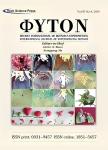Antifungal Activity of Crude Extracts of Tectona grandis L.f. against Wood DecayFungi
作者机构:Facultad de Ingeniería en Tecnología de la MaderaUniversidad Michoacana de San Nicolás de HidalgoMorelia58030México Instituto de Investigaciones Químico-BiológicasUniversidad Michoacana de San Nicolás de HidalgoMorelia58030México
出 版 物:《Phyton-International Journal of Experimental Botany》 (国际实验植物学杂志(英文))
年 卷 期:2022年第91卷第8期
页 面:1795-1808页
核心收录:
学科分类:0710[理学-生物学] 07[理学] 070303[理学-有机化学] 0703[理学-化学]
基 金:Thanks to CONACYT for the scholarship granted(2019-000002-01NACF-13536).
主 题:Tectona grandis wood deterioration naphthoquinone antifungal activity wood protection
摘 要:Wood is mainly made up of cellulose, hemicelluloses, lignin polymers and other organic and inorganic substances, making it susceptible to deteriorate by various biological agents. Tectona grandis L.f. (Teak) is a timberspecies with high resistance to biological deterioration, valued for its durability, beauty, and mechanical resistance.The purpose of this work was to evaluate the antifungal activity of crude extracts from teak on various fungi thatcause wood deterioration. For this, Teak heartwood was obtained, then fragmented and pulverized until obtaininga flour which was used for compounds extraction using the Soxhlet technique coupled to a rotary evaporatorthrough solvents of increasing polarity (hexane, dichloromethane, tetrahydrofuran, and acetone). The extractsobtained were tested against fungal organisms collected in the field, and the LC50 was determined using teak crudeextracts on Artemia salina as a biological model. The results obtained showed that a high flour yield was obtainedwith hexane (0.951 g), followed by tetrahydrofuran (0.446 g), dichloromethane (0.348 g), and acetone (0.152 g). Byusing nine fungal organisms that predominantly correspond to the genus Aspergillus, the extractable compoundswere tested, inhibiting 25% of mycelial growth with tetrahydrofuran (T. versicolor), and 40.9% with dichloromethane(G. trabeum). Likewise, the biological model of A. salina showed an LC50 of 84.9 μg/mL with hexane, 43.3 μg/mLwith dichloromethane, 59.6 μg/mL with tetrahydrofuran, and 54.7 μg/mL with acetone. For this reason, it is concluded that Teak wood contains many extractable compounds in relation to its weight, besides having antimicrobialactivity when extracted through polar compounds such as dichloromethane and tetrahydrofuran.



